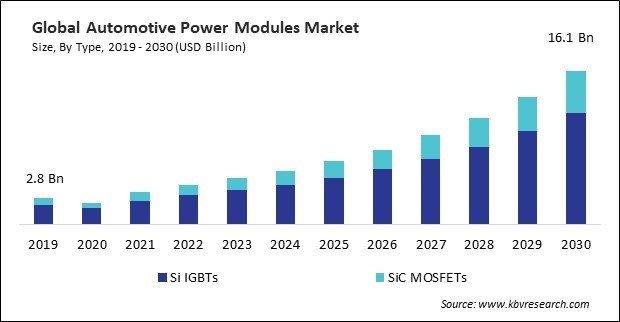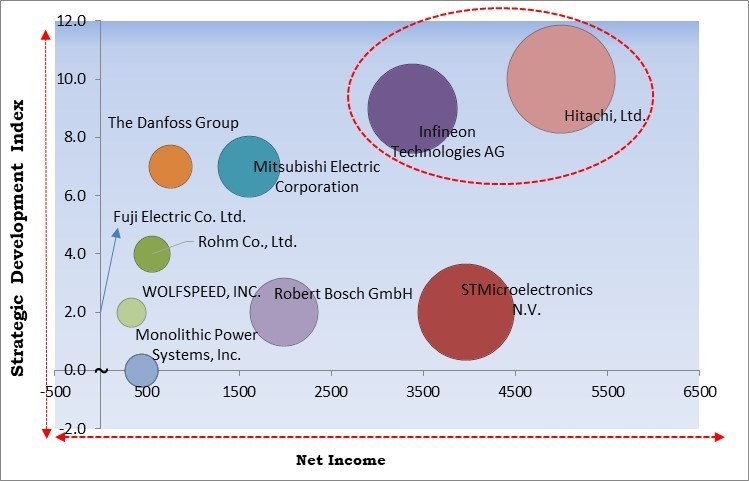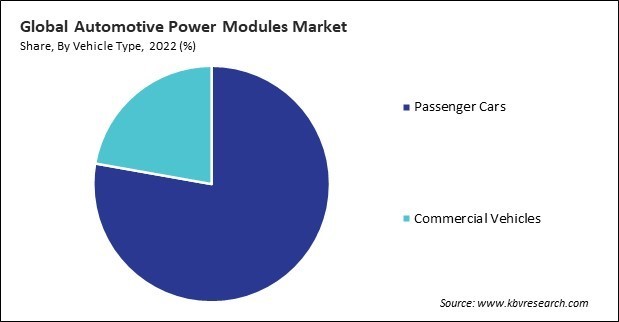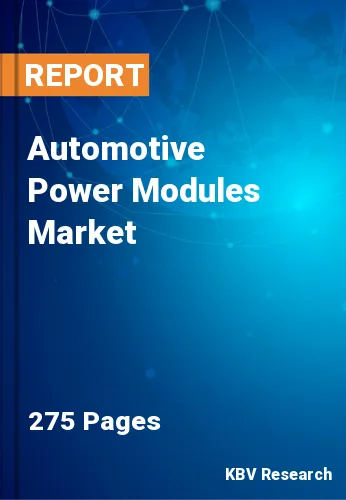“Global Automotive Power Modules Market to reach a market value of USD 16.1 Billion by 2030 growing at a CAGR of 18.6%”
The Global Automotive Power Modules Market size is expected to reach $16.1 billion by 2030, rising at a market growth of 18.6% CAGR during the forecast period.
Governments in North America, at both the federal and state levels, are implementing various incentives and regulatory measures to promote the adoption of electric vehicles. Therefore, the North America region captured $1,149.2 million revenue in the market in 2022. These include tax credits, rebates, and stricter emission standards. Automotive power modules are crucial in enabling compliance with these regulations and leveraging the available incentives.

The major strategies followed by the market participants are Partnerships, Collaborations & Agreements as the key developmental strategy to keep pace with the changing demands of end users. For instance, In November, 2023, Mitsubishi Electric Corporation came into a partnership with Nexperia B.V. Under this partnership, the companies developed silicon carbide (SiC) power semiconductors. Additionally, In June, 2023, STMicroelectronics N.V. entered into an agreement with SANAN Optoelectronics Co., Ltd. Under this agreement, a 200-mm silicon carbide device manufacturing joint venture was formed in Chongqing, China. Additionally, the joint venture assisted in offering foundry services to ST and satisfying the demands of its Chinese customers.
Based on the Analysis presented in the KBV Cardinal matrix; Infineon Technologies AG and Hitachi, Ltd. are the forerunners in the market. In October, 2022, Infineon Technologies AG came into a partnership with VinFast Auto, LLC, a Vietnam-based multinational automotive company. Under this partnership, the VinFast-Infineon Competence Center (VICC) was introduced. Additionally, the partnership assisted in providing smart mobility solutions and achieving supply chain stability. Companies such as Mitsubishi Electric Corporation, STMicroelectronics N.V., Robert Bosch GmbH are some of the key innovators in the market.

Electrified vehicles, especially fully electric ones, rely on electric drivetrains to generate propulsion. These drivetrains require sophisticated power electronics to manage the flow of electricity, control the electric motor, and optimize energy efficiency. Power modules play a crucial role in these systems. High-voltage battery packs power electrified vehicles. These modules are essential components in battery management systems, helping regulate the charging and discharging of batteries, ensuring safety, and optimizing overall battery performance. In addition, electric vehicles convert direct current (DC) from the battery to alternating current (AC) for the electric motor via inverters. In conclusion, the growing electrification of vehicles propels the market's growth.
Many governments worldwide offer financial incentives and subsidies to consumers purchasing electric or hybrid vehicles. These incentives can be tax credits, rebates, reduced registration fees, or direct financial support, making electric and hybrid vehicles more economically attractive. As the demand for these vehicles increases, there is a corresponding rise in the need for advanced power modules crucial for electric drivetrains. Additionally, governments may provide grants and funding for research and development activities in the automotive sector, including developing advanced power modules. Hence, the increasing government support for the EV industry is driving the growth of the market.
Designing and developing advanced power modules with cutting-edge technologies involves substantial R&D costs. The initial investment required for creating innovative solutions that meet the performance, efficiency, and safety standards can be considerable. The manufacturing processes for advanced power modules, especially those incorporating the latest semiconductor technologies, can be intricate and require specialized facilities. High precision and quality control measures increase manufacturing costs, contributing to the overall initial cost of production. High-quality materials and advanced components in power modules contribute to their performance and reliability. Therefore, the high initial cost is impeding the growth of the market.
Based on type, the market is bifurcated into SiC MOSFETs and Si IGBTs. The SiC MOSFETs segment attained a considerable revenue share in the market in 2022. SiC MOSFETs can operate at higher temperatures. This capability reduces the need for extensive cooling systems, contributing to a more compact and lightweight design of automotive power modules. The ability to withstand elevated temperatures enhances the overall thermal performance of the system. Therefore, the ability to work properly in higher temperatures propels the demand for the segment.
On the basis of vehicle type, the market is segmented into passenger cars and commercial vehicles. The passenger cars segment recorded the largest revenue share in the market in 2022. Passenger cars, especially those with electric or hybrid powertrains, heavily rely on power electronics to manage and control the flow of electrical energy between the battery, electric motor, and other components. These play a critical role in this process, influencing the overall performance, efficiency, and range of electric and hybrid passenger cars.

Based on propulsion type, the market is categorized into battery electric vehicle (BEV) and hybrid electric vehicle (HEV). The hybrid electric vehicle (HEV) segment witnessed a considerable revenue share in the market in 2022. Hybrid electric vehicles operate on a combination of internal combustion engines and electric motors. These are crucial in optimizing power distribution between these two sources. Power modules manage the energy flow, allowing the vehicle to operate in different modes, such as pure electric mode, hybrid mode, or internal combustion engine mode, based on driving conditions and efficiency considerations. Hence, the optimal power distribution is a factor behind the segment's growth.
By application, the market is divided into traction inverter, DC-DC inverter, and on-board charger. The on-board charger segment procured a remarkable revenue share in the market in 2022. On-board chargers are designed to be compact and integrated directly into the vehicle's powertrain. This integration minimizes space requirements and simplifies the overall vehicle architecture. Consequently, the demand for on-board chargers with compact designs is influenced by the need to optimize space utilization and reduce the weight of electric and hybrid vehicles.
Free Valuable Insights: Global Automotive Power Modules Market size to reach USD 16.1 Billion by 2030
Region-wise, the market is analyzed across North America, Europe, Asia Pacific, and LAMEA. In 2022, the Asia Pacific region witnessed the maximum revenue share in the market. The Asia Pacific region hosts several of the most sizable and rapidly expanding automotive industries globally, such as Japan, China, and India. In conjunction with the growth of the automotive sectors in these nations, growing customer demand for hybrid and electric cars drives the demand for sophisticated automotive power modules.
| Report Attribute | Details |
|---|---|
| Market size value in 2022 | USD 4.1 Billion |
| Market size forecast in 2030 | USD 16.1 Billion |
| Base Year | 2022 |
| Historical Period | 2019 to 2021 |
| Forecast Period | 2023 to 2030 |
| Revenue Growth Rate | CAGR of 18.6% from 2023 to 2030 |
| Number of Pages | 275 |
| Number of Tables | 413 |
| Report coverage | Market Trends, Revenue Estimation and Forecast, Segmentation Analysis, Regional and Country Breakdown, Competitive Landscape, Porter’s 5 Forces Analysis, Company Profiling, Companies Strategic Developments, SWOT Analysis, Winning Imperatives |
| Segments covered | Type, Vehicle Type, Propulsion Type, Application, Region |
| Country scope |
|
| Companies Included | Infineon Technologies AG, Mitsubishi Electric Corporation, Fuji Electric Co. Ltd., STMicroelectronics N.V., Monolithic Power Systems, Inc., The Danfoss Group, Robert Bosch GmbH, Hitachi, Ltd., Rohm Co., Ltd., WOLFSPEED, INC. |
By Type
By Vehicle Type
By Propulsion Type
By Application
By Geography
The Market size is projected to reach USD 16.1 billion by 2030.
Increasing electrification in vehicles are driving the Market in coming years, however, High initial cost of advanced technologies restraints the growth of the Market.
Infineon Technologies AG, Mitsubishi Electric Corporation, Fuji Electric Co. Ltd., STMicroelectronics N.V., Monolithic Power Systems, Inc., The Danfoss Group, Robert Bosch GmbH, Hitachi, Ltd., Rohm Co., Ltd., WOLFSPEED, INC.
The expected CAGR of this Market is 18.6% from 2023 to 2030.
The Si IGBTs segment is generating highest revenue in the Modules Market, By Type in 2022; there by, achieving a market value of $11.7 Billion by 2030.
The Asia Pacific region dominated the Market, By Region in 2022, and would continue to be a dominant market till 2030; there by, achieving a market value of $6.3 Billion by 2030.
Our team of dedicated experts can provide you with attractive expansion opportunities for your business.

 Drivers
Drivers
 Restraints
Restraints
 Opportunities
Opportunities
 Challenges
Challenges
